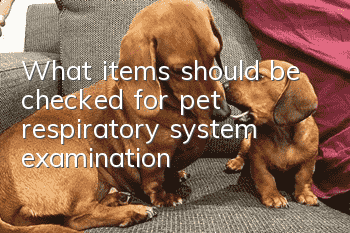What items should be checked for pet respiratory system examination?

Pet hospital doctors often find that many pets have respiratory system diseases during hospital treatment. In order to make everyone familiar with pet respiratory system diseases, Ruipeng Pet Hospital will introduce respiratory system examinations to pet owners below.
(1) Respiratory action inspection.
Including examination of respiratory count, breathing pattern, respiratory rhythm, and dyspnea.
⒈Respiratory examination: The normal breathing pattern of dogs is rather special and is chest breathing. Thoracic and abdominal breathing are more common in pleurisy, pleural effusion and rib fractures.
⒉Examination for dyspnea Dyspnea is one of the common symptoms of respiratory diseases, which can be divided into:
⑴ Inspiratory dyspnea: manifested by opening the mouth, straightening the head and neck, shifting the ribs back and forward, and abducting the elbows, as well as a depression at the front of the thorax during inhalation. If accompanied by noise, it is more common in upper respiratory tract stenosis caused by tumors and foreign bodies. Frequent breathing, such as shallow breathing, indicates that the lungs cannot fully expand, which is seen in rib fractures, pneumonia, pneumothorax, or pleurisy.
⑵ Expiratory dyspnea: manifested by prolonged expiration time, laboriousness, abdominal tightening, and anal protrusion. It is seen in ① chronic emphysema (a high decrease in alveolar elasticity); ② bronchiolitis (narrowing of the bronchioles).
Mixed dyspnea: pulmonary dyspnea (severe pneumonia, pulmonary edema), thoracoabdominal dyspnea (pneumothorax or pleural effusion, increased abdominal pressure disease), cardiogenic dyspnea (heart failure, cardiac arrest) Enditis), hematogenous dyspnea (severe anemia, or hemoglobin degeneration disease), toxic dyspnea (uremia, barbiturate poisoning, etc.), central dyspnea (encephalitis, cerebral hemorrhage, cerebral hemorrhage, etc.) Edema) and febrile illness can cause mixed dyspnea.
⒊Respiratory rhythm examination Normal dogs and cats breathe rhythmically, and the ratio of inhalation and exhalation time is 1:⒈6. Pathological changes in respiratory rhythm include prolonged inhalation, prolonged expiration, intermittent breathing (chronic alveolar emphysema, bronchiolitis, and painful chest and abdominal diseases, etc.) and Cheyne-Stokes breathing caused by failure of the respiratory center (encephalitis, Heart failure, uremia and poisoning diseases, etc.), intermittent breathing (severe encephalitis, uremia, etc.), deep and long breathing (metabolic alkalosis).
(2) Cough and nasal fluid examination.
Cough and runny nose are common symptoms of the respiratory system.
⒈Cough examination: Coughing occurs when the animal lowers its head, opens its mouth, and takes short breaths. Artificial cough induction can be used to observe the cough. Common pathological coughs are divided into: dry cough, foreign bodies in the throat and trachea, chronic bronchitis, pleurisy, etc. Wet cough often involves a large amount of exudate being ejected from the nostrils with coughing. When there is swallowing after coughing, it is also called wet cough. It is common in pharyngitis, bronchopneumonia, lung abscess, etc. Thin cough, common in colds, tuberculosis, etc. Paroxysmal cough, seen in acute laryngitis, infectious upper respiratory tract catarrh, upper respiratory tract foreign bodies and foreign bodiesPhysical pneumonia, etc. Painful cough, common in acute laryngitis, laryngeal edema, etc. Hemoptysis is more common in lung cancer, paragonimiasis or heartworm disease. In addition, collar compression, sudden movement, or stimulation by cold or dirty air can also cause coughing.
⒉ Nasal fluid examination Respiratory disease nasal fluid is characterized by recovery or worsening from serous "mucus" to mucopurulent. Watery nasal fluid is common in rhinitis, colds, early stages of canine distemper, etc. Purulent nasal fluid is seen in suppuration. Sexual bacterial infection; sinusitis, maxillary sinusitis; the middle and late stages of canine distemper. Bloody nasal fluid is more common in trauma, nasal foreign bodies, nasal mucosal ulcers, nasal tumors, etc.
(3) Lung auscultation.
Normal breath sounds are divided into two types: alveolar breath sounds and bronchial breath sounds. ① Alveolar breath sounds are the sounds produced when gas passes through the bronchioles and alveoli. They are similar to the sound of "husband" and are clearer when inhaling than when exhaling. The alveolar breath sounds of dogs and cats can be heard throughout the lung area, and are stronger and louder than those of other animals. ② Bronchial breath sounds are the sounds produced when gas passes through the large bronchi and small bronchi. The bronchial breath sounds are relatively clear during exhalation. Normally, similar sounds can only be heard above and below the level of the shoulder joint in the 3rd to 4th intercostal space (i.e., the hilar area). "Her" bronchial breath sounds. Therefore, healthy dogs and cats can hear mixed breath sounds of "fu, he" and "fu, he" in the hilar area of the lungs as they breathe, while many only hear alveolar breath sounds in other lung areas.
- How do you know your dog has entered the birth canal?
- Prevention and treatment of heatstroke in dogs!
- How much dog food should you feed an Alaskan puppy?
- Why are dogs allergic to dog food? What specific symptoms?
- 8 common reasons why dogs vomit
- What is the cause of alopecia in dogs?
- What kind of dog food is good for Huskies? What else should you pay attention to when choosing dog food?
- The Three Stages of Scottish Sheepdog Training
- How to tell the difference between an Alaskan and a Husky
- What should I do if Corgi is picky and won’t eat dog food?



